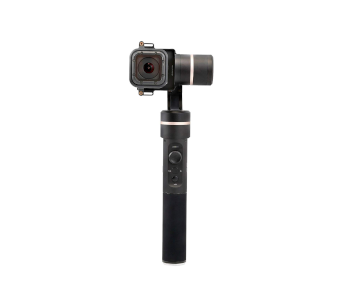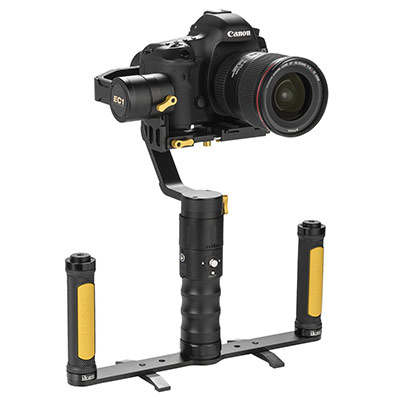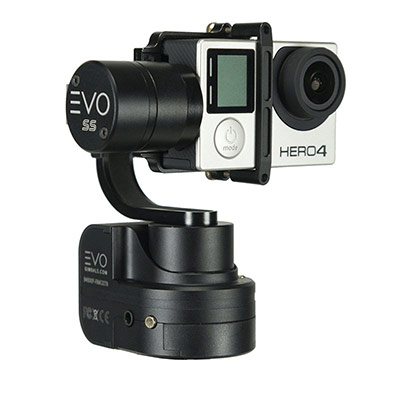What is A Gimbal? How it Works and Why You Should Use One
Dynamic video shots are best captured using a handheld camera. Filmmakers know this and have been using this technique for decades. However, the disadvantage of a camera held by a person instead of mounted on a boom or tripod is that a person tends to make a lot of extraneous movements, which tends to make footage move erratically.
Gimbals may be a relatively new piece of technology, but they have become massively popular in the last couple of years. They have even replaced some of the equipment that professional filmmakers used in the past. What are these gimbals anyway and how do they work? When should you be using a gimbal?
Steadicam: the father of gimbals
In a nutshell, gimbals help filmmakers record smoother videos by counter-acting any extraneous movements brought about by the cameraman and the environment. This is a concept that existed way before gimbals were developed in the form of the Steadicam.
First used in the 1970s, the Steadicam was a rig that combines allowed cameramen to capture handheld videos with the stability and smoothness that was previously only possible with a dolly. The first Steadicam was a massively complicated design that consisted of a camera sled, and iso-elastic arm, and a supportive vest that the cameraman had to wear the support all the weight of the hardware.
With the Steadicam, the camera operator can do perfectly smooth panning since the movement of the camera was restricted along the “rails” of the camera sled. The iso-elastic arm acted as a shock absorber of sorts, canceling out any extraneous up and down movements that the cameraman unwittingly makes. Finally, the Steadicam relied on the principle of the center of gravity to perfectly stabilize the camera.
Just from looking at the photo of a Steadicam, you can figure out what makes it such as difficult piece of equipment to use. The old-fashioned Steadicam was a massive contraption that was almost as tall as the cameraman and had a lot of moving parts. A lot of the work needed to shoot stable videos in a Steadicam had to be done manually by the cameraman. Not only did this require a lot of effort, but it was also an entirely different skill that cameramen had to learn.
Even with the prevalence of gimbals, the Steadicam technology is still around nowadays. Modern Steadicams are much smaller than what they used to be and might be easier to use. However, they are still pretty big and heavy, and certainly too complex for any amateur to just pick up and start operating. Although they still have their place in the professional filmmaking industry, they simply had no mass appeal – and that’s where gimbals held the advantage.
Gimbals: the new generation of video stabilization

Gimbal technology isn’t actually exclusive to cameras and filmmaking. It’s a technology that has been heavily used for general navigation, in marine chronometers, and even in spacecraft propulsion. Interestingly, the field of rocket science has taken to using the word “gimbal” as a verb to describe the movement that a rocket’s thrust chamber makes when it is swung by an attached actuator.
Gimbals make several crucial changes to the working concept of the Steadicam. Whereas the Steadicam required a lot of skill and manual effort in the part of the cameraman, a gimbal offered a smarter solution. Instead of relying on the fundamental physical mechanism to keep a camera stable, the gimbal mounted the camera on three independent arms. Each of the three arms rotates along different axes via the action of brushless motors.
The automated nature of how gimbals work has made them much more accessible to amateur filmmakers. In the early days, professional-grade gimbals were also quite big – two-handed models were very commonly used in commercial films. As the years went by, gimbals became smaller and smaller, possibly culminating in the first pocket-sized gimbal from DJI, the Osmo Pocket. It is the portability and ease of use of gimbals that have caused this filmmaking technology to skyrocket in popularity in the last few years.
How a gimbal works
It’s pretty obvious that there’s a complex mechanism that lies behind the “smart” stabilization system of gimbals. What exactly lies under the hood of a gimbal, and how do all these components work together?
1. Accelerometers and gyroscopes

The technology that allows gimbals to determine any untoward movement is far more common than you may think. Accelerometers and gyroscopes, complicated as they may seem, are components of any basic smartphone. They allow the software in your phone to determine what direction the phone is pointed to, as well as if the phone is being rotated or tilted. But how do an accelerometer and a gyroscope work, anyway?
An accelerometer is a sensor that detects if an object is moving in any direction. There are several different types of accelerometers, but the most commonly used in electronics is the piezoelectric variant. This type of accelerometer uses microscopic crystals (called piezometric crystals) that produce a current whenever they undergo stress. As a gimbal moves in any direction, the force of this movement is enough to induce this stress which then results in the crystals producing a current. The strength of the current is directly proportional to the magnitude of the accelerative force, thus providing feedback to how quickly the gimbal is moving.
A gyroscope simply consists of a spinning disk mounted on a movable frame. The disk continuously spins, following the concept of conservation of angular momentum. Without any external force acting on it, the axis of rotation of the disk remains permanent, even when the frame in which it is mounted on tilts or rotates. Thus, the spinning disk acts as the inertial reference frame for the rotation of the gimbal along any axis. These three directions of rotation are referred to as pitch, yaw, and roll.
2. Firmware
The combination of 3-axis accelerometers and 3-axis gyroscopes allow a gimbal to collect information about how it moves. How does the gimbal use this information to keep the camera stable?
This is the job of the gimbal’s firmware. Unlike a Steadicam which works on a purely physical level, there is a ‘brain’ behind how a gimbal works. The software embedded in a gimbal receives the data generated by the accelerometers and gyroscopes and uses this data to issue instructions to the relevant components. All of this is in accordance with the overall objective of the gimbal: to counteract any unnecessary movements and maintain the stable position of the camera.
The firmware is also able to filter if the actions detected by the sensors are extraneous (and need to be corrected) or purposively done by the user.
Of course, a gimbal’s firmware has more duties than simply directing how and when the rotating arms should move. The firmware also receives commands based on user input, such as when to start recording videos, activate intelligent camera modes, or adjust camera settings. The firmware of a gimbal is just as important as any of its hardware, and it is through firmware updates that gimbal manufacturers are able to roll out incremental upgrades or patches for performance improvement.
3. Brushless motors
Lastly, each of the three rotating arms has a brushless motor that receives commands from the firmware on when it should rotate. This can either be in response to an extraneous movement or from a direct command from the user.
Brushless motors are ideal for gimbal because they are lighter and smaller. They are also much more silent than their brushed equivalents – after all, what’s the point of a smooth video if all you can hear is the whirring of motors? To top it all off, brushless motors are very low maintenance, so you should be able to get years of use before you’ll need to have them replaced.
Should you be using a gimbal?
Even though gimbals have become incredibly common, the fact remains that they can still be quite expensive. There aren’t even many gimbals that come with an integrated camera. In most cases, you’ll have to buy the photography equipment yourself. Gimbals may not be for everyone, but how will you know if it’s for you? When is it a good idea to invest in a gimbal?
1. You want to shoot perfectly smooth videos

There’s a certain visual flair and flexibility to shooting things on a handheld camera. Shots are more dynamic and interesting, and you even have the opportunity to come up with shooting angles on the fly. In this era where vlogging reigns supreme, handheld filmmaking has become a mainstream technique.
You probably know this but shooting handheld videos without a gimbal will never be perfectly smooth. Even walking around with your front-facing camera pointed to your face will inevitably result in a video that is bouncy or jittery. Taking it to the other extreme, you might also be considering capturing a perspective video during your hike, run, or biking trip. Without any stabilization, nobody will want to watch that video.
A good gimbal can work in any of the environments we have mentioned. It doesn’t matter if you’re just walking around or if you’re bouncing around hills on your bike – a well-designed gimbal should help you keep your videos perfectly smooth and stable.
2. You have small and lightweight photography equipment
A major limitation of gimbals that is not as big of a concern in the era of Steadicam is the size and weight of the photography equipment. In a gimbal, the camera is mounted on three rotary arms that are powered by small brushless motors. These motors have a power rating – anything beyond that and they will almost certainly fail.
Before you buy that new gimbal, check to see its weight capacity first. You might have to use extra large cameras and zoom lenses that are beyond the carrying capacity of your gimbal. Also keep in mind that the smaller a gimbal is, the less weight capacity it can withstand.
3. You’re always on the go
Today, there are a bunch of different gimbal products on the market. There’s a gimbal that can fit in your market, a professional-grade gimbal that you can hold in one hand, and a special gimbal designed to be used with your camera phone. One surprising trend seems to be common in all types of gimbals though: they are getting lighter and smaller.
A gimbal is the perfect photography accessory for the filmmaker who’s always on the go. This can include documentary producers, travel and lifestyle vloggers, or extreme adventurers who simply want to document their exploits.
4. You’re a solo filmmaker
All of the recently released gimbal models share a common design principle: they are meant to be used with just one hand. Modern gimbals have placed all the fundamental commands within reach of your fingers with trigger buttons, focus wheels, quick mode buttons, and intuitive touchscreen panels.
This level of accessibility that gimbals have provided has made it possible for filmmakers to capture stunning videos even when they’re flying solo. There are even some gimbals that can convert into a tripod or can be mounted using the standard GoPro tripod mount.
5. You want to do filmmaking professionally
Whether you’re trying to capture videos that you can sell or want to start your own vlogging channel, using a gimbal to stabilize your videos is practically a minimum. It adds a touch of professionalism to your videos without losing out on the adventurous spirit of shooting handheld.
Final thoughts
There was a time when amateur photography became such a huge thing that everyone and their brother ended up buying their own DSLRs. That time has come and gone, but we expect gimbals to have a similar phenomenon soon. Aside from the fact that most gimbals aren’t as expensive as a DSLR camera, they produce great results and are incredibly fun to use.
If you’re still on the fence about getting a gimbal, then how about trying out a cheap one first? The Osmo Pocket pocket-sized gimbal with an integrated camera from DJI costs just a little above $300. You can also get the latest release, the Osmo Mobile 3, a gimbal designed to hold your camera phone costs just around $120.

